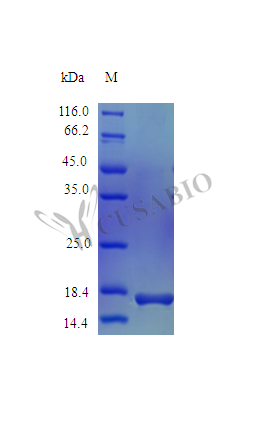Recombinant Mouse Interleukin-36 beta protein (Il36b) is made using an E.Coli expression system and contains the complete mature protein sequence from amino acids 31 to 183. This tag-free protein shows high purity—more than 97% according to SDS-PAGE analysis. The protein appears to have considerable biological activity, with an ED50 of less than 10 ng/ml when triggering IL-6 secretion in murine NIH/3T3 cells. This translates to a specific activity exceeding 1.0 × 10^5 IU/mg. Endotoxin levels stay below 1.0 EU/µg, as measured by the LAL method.
Interleukin-36 beta (Il36b) belongs to the interleukin-1 family and seems to play an important role in immune system communication. The protein is involved in controlling inflammatory responses and is known to trigger pathways that lead to cytokine production, including IL-6. Because of its role in immune regulation, Il36b has become a key focus for researchers studying inflammation and related biological processes.
Potential Applications
Note: The applications listed below are based on what we know about this protein's biological functions, published research, and experience from experts in the field. However, we haven't fully tested all of these applications ourselves yet. We'd recommend running some preliminary tests first to make sure they work for your specific research goals.
1. IL-6 Induction Assays in Murine Cell Lines
This recombinant mouse IL-36β protein is confirmed to be biologically active (ED₅₀ < 10 ng/ml for IL-6 induction in murine NIH/3T3 cells) and suitable for studying IL-36β-mediated inflammatory signaling. The specific activity (>1.0×10⁵ IU/mg) provides a reliable quantitative reference for dose-response studies of cytokine production. Researchers can confidently use this protein to investigate molecular mechanisms of IL-36β signaling in murine cell systems, with the high purity (>97%) ensuring minimal contaminant interference.
2. Antibody Development and Validation
The high purity and tag-free design make this IL-36β protein appropriate for antibody development. The confirmed biological activity indicates proper folding, supporting the generation of antibodies that recognize functional epitopes. However, researchers should validate resulting antibodies using both this recombinant protein and native IL-36β from mouse samples to ensure recognition of physiologically relevant forms in different assay formats (ELISA, Western blot, immunoprecipitation).
3. Protein-Protein Interaction Studies
This biologically active IL-36β is suitable for studying interactions with its cognate receptor (IL-1Rrp2) and other binding partners. The mature protein sequence (31-183aa) represents the functional domain, and the high purity minimizes contaminant interference. However, as the protein is expressed in E. coli and lacks mammalian post-translational modifications, any novel interactions identified should be validated with mammalian-expressed IL-36β or in native cellular contexts.
4. Comparative Species-Specific Inflammatory Response Studies
The mouse-specific sequence enables valid studies of IL-36β function in murine systems. The demonstrated activity in NIH/3T3 cells provides a reliable baseline for investigating mouse-specific signaling pathways. However, direct cross-species comparisons require caution due to potential differences in receptor affinity and signaling potency between mouse and human IL-36β systems. Comparative studies should include appropriate controls for species-specific variations.
5. Cytokine Network Analysis in Inflammatory Models
This IL-36β protein can be used to study its role within cytokine networks, particularly given its demonstrated ability to induce IL-6. The low endotoxin content ensures that observed effects are specifically attributable to IL-36β activity. However, when studying complex cytokine interactions, researchers should consider that E. coli-expressed protein may exhibit slightly different kinetics compared to native IL-36β in some inflammatory contexts.
Final Recommendation & Action Plan
This E. coli-expressed mouse IL-36β protein is a validated research tool suitable for all proposed applications, with its biological activity confirmed through specific IL-6 induction assays. For immediate use, employ it in IL-6 induction studies and inflammatory signaling research in murine cell models, leveraging the established ED₅₀ for dose-response experiments. When developing antibodies, this protein is ideal for immunization and assay development, but validating resulting antibodies in physiological contexts. For interaction studies, the confirmed bioactivity ensures reliable results for IL-1Rrp2 binding characterization, though novel interactions should be confirmed with native protein. While the E. coli expression system produces a non-glycosylated protein, the demonstrated biological activity indicates proper folding for receptor engagement and function. For all applications, include proper controls and consider that the specific activity, while sufficient for most assays, is moderate compared to some cytokines, so optimize concentrations accordingly for different experimental setups.






